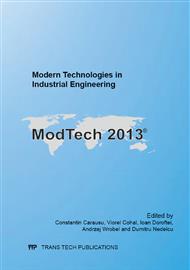p.190
p.196
p.201
p.206
p.212
p.218
p.223
p.228
p.234
Researches for the Optimization of the Dehydration Process for Plums and Apricots
Abstract:
The dehydration of the products of vegetable origin is a complex technological process, involving heat and mass transfer, which is largely affected by the nature and characteristics of the fruits, but also by the technical performances of the equipment. Experimental laboratory tests must be performed in order to evaluate the effect and importance of these parameters, using equipments which are able to reproduce the technological dehydration process. In order to achieve these goals a specialized test rig was designed and built. The laboratory test rig allows different dehydration experiments to be carried out; all the parameters that affect the dehydration process - temperature, speed and humidity of the drying agent before and after the mass and heat transfer takes place, the weight and temperature of the dehydrated product, the direction of the drying agent etc. - are continuously monitored. The continuous monitoring of the working parameters is performed by the means of a specialized industrial computer, which allows the data aquision and transfer to a PC. The paper presents the details regarding the design and working process of the laboratory test rig, as well as the experimental results concerning the dehydration of plums and apricots. The results show that the dehydration process is affected by the temperature and speed of the drying agent, by the size of the particles and by the thickness of product layer.
Info:
Periodical:
Pages:
212-217
Citation:
Online since:
November 2013
Authors:
Keywords:
Price:
Сopyright:
© 2014 Trans Tech Publications Ltd. All Rights Reserved
Share:
Citation:


